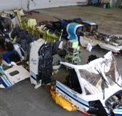 The first Notable Narrative for September takes a police procedural as its template. The article begins with the loss of a Sikorsky S-92 helicopter in March 2009 off the coast of Newfoundland in Canada. This Esquire story from Chris Jones tracks the investigators who work to unravel the cause and manner of death for all but one of the 18 people on board the aircraft.
The first Notable Narrative for September takes a police procedural as its template. The article begins with the loss of a Sikorsky S-92 helicopter in March 2009 off the coast of Newfoundland in Canada. This Esquire story from Chris Jones tracks the investigators who work to unravel the cause and manner of death for all but one of the 18 people on board the aircraft.By centering his narrative arc on an event, Jones frees himself to follow multiple team members as they attend to their duties, from conducting autopsies to searching the ocean floor. Mini-narratives about each investigator, with a true lead and kicker for each, make up many of the scenes in the story. In the online version, the page breaks mirror the scene breaks, making for more dynamic electronic reading than is typical with long-form journalism.
A story about titanium studs and other minutiae of disaster investigation could easily have made this a workmanlike piece to be read and forgotten. But Jones welds his just-the-facts account to a startling lyricism.
The closing scene, in which Jones turns his attention from the dead to lone survivor Robert Decker, is among the best we’ve read. No matter how well the investigators do their jobs, he writes, Decker will wonder how he escaped; he will never “be able to read a report that will tell [him] the cause and the manner of life.”


